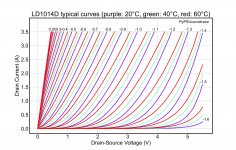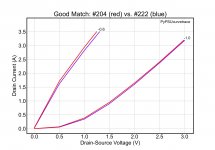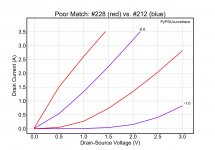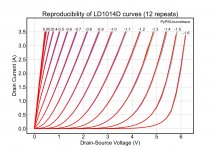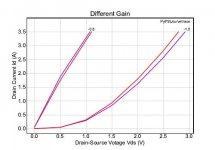Edit Feb. 2024: You want parts? Read this post carefully. Do what it says, all of it. Otherwise your PM might not get an answer.
This thread is for getting my big stash of tested and matched LD1014D (LU1014D) JFETs out to the DIY world!
So far I have tested and matched several hundred parts by temperature-controlled Vgs measurement and curve tracing (see details below). Additional parts will be added as testing progresses. These parts are perfect for building a DAO headphone amp, ZEN 9, F3, LuFo, SuSyLu, etc.!
See here for more information on how to find good matches from the data provided at the link below.
Test procedures:
All parts are testing and matched using PyPSUcurvetrace with calibrated power supplies, using two test methods:
Vgs data are recorded in a list (sorted by Vgs, see link below).
Curve traces are plotted for pairs which have Vgs values that are matched to 30 mV or better (Type B only).
Prices:
Matching data and part availabilities are here:
How to order your parts:
This thread is for getting my big stash of tested and matched LD1014D (LU1014D) JFETs out to the DIY world!
So far I have tested and matched several hundred parts by temperature-controlled Vgs measurement and curve tracing (see details below). Additional parts will be added as testing progresses. These parts are perfect for building a DAO headphone amp, ZEN 9, F3, LuFo, SuSyLu, etc.!
See here for more information on how to find good matches from the data provided at the link below.
Test procedures:
All parts are testing and matched using PyPSUcurvetrace with calibrated power supplies, using two test methods:
- Type A test: measure the the Gate-Source voltage (Vgs) required for a Drain current (Id) of 1.5 A at Drain-Source voltage (Vds) of 2.4 V.
- Type B test: like Type A, but additionally also measure Id vs. Vds curves at Vgs = -0.6 V and -1.0 V.
Vgs data are recorded in a list (sorted by Vgs, see link below).
Curve traces are plotted for pairs which have Vgs values that are matched to 30 mV or better (Type B only).
Prices:
- Type A parts: EUR 10 per piece
- Type B parts: EUR 15 per piece
- Shipping and handling per envelope: EUR 10 (international) or EUR 5 (Switzerland)
Matching data and part availabilities are here:
- List with Vgs data and parts availability
- Curve matching as described here
- Parameters (Vgs, gain, etc.)
How to order your parts:
- Post a quick reply to this thread indicating your interest in getting some LD1014s.
Enter your details and the LD1014 part numbers in this form.
Send me a PM with your desired LD1014 sample numbers, your full name and address (including country!), phone number (needed for shipping), and email address.- Wait for my reply with payment instructions.
Attachments
Last edited:
I was asked about the uncertainty of the measurements. Here you go:
(1) Accuracy: the PSUs are calibrated to my Fluke DMM with an accuracy of 1 mV / 1 mA.
(2) Precision: I measured the same part 12 times, on different days. The reproducibility of the Vgs values is explained by the resolution of the power supplies (1 mV), which is about 0.1 % of the Vgs value.
I also attached an overlay of the 12 curve traces so you can see they reproduce.
LD1014D_270_20220103_REP_1: Vgs = -1.038
LD1014D_270_20220104_REP_1: Vgs = -1.04
LD1014D_270_20220104_REP_2: Vgs = -1.039
LD1014S_270_20220105_REP_1: Vgs = -1.042
LD1014D_270_20220105_REP_2: Vgs = -1.039
LD1014D_270_20220105_REP_3: Vgs = -1.04
LD1014D_270_20220105_REP_4: Vgs = -1.039
LD1014D_270_20220105_REP_5: Vgs = -1.04
LD1014D_270_20220105_REP_6: Vgs = -1.04
LD1014D_270_20220105_REP_7: Vgs = -1.04
LD1014D_270_20220106_REP_1: Vgs = -1.041
LD1014D_270_20220106_REP_2: Vgs = -1.041
Mean Vgs = -1.0399166666666666 V
StdDev Vgs = 0.0010374916331657338 V
RSD Vgs = 0.0997668050163379 %
(1) Accuracy: the PSUs are calibrated to my Fluke DMM with an accuracy of 1 mV / 1 mA.
(2) Precision: I measured the same part 12 times, on different days. The reproducibility of the Vgs values is explained by the resolution of the power supplies (1 mV), which is about 0.1 % of the Vgs value.
I also attached an overlay of the 12 curve traces so you can see they reproduce.
LD1014D_270_20220103_REP_1: Vgs = -1.038
LD1014D_270_20220104_REP_1: Vgs = -1.04
LD1014D_270_20220104_REP_2: Vgs = -1.039
LD1014S_270_20220105_REP_1: Vgs = -1.042
LD1014D_270_20220105_REP_2: Vgs = -1.039
LD1014D_270_20220105_REP_3: Vgs = -1.04
LD1014D_270_20220105_REP_4: Vgs = -1.039
LD1014D_270_20220105_REP_5: Vgs = -1.04
LD1014D_270_20220105_REP_6: Vgs = -1.04
LD1014D_270_20220105_REP_7: Vgs = -1.04
LD1014D_270_20220106_REP_1: Vgs = -1.041
LD1014D_270_20220106_REP_2: Vgs = -1.041
Mean Vgs = -1.0399166666666666 V
StdDev Vgs = 0.0010374916331657338 V
RSD Vgs = 0.0997668050163379 %
Attachments
Some people asked about the best ways to find good matches. Not everyone is used to look at transistor parameters and curves, so here are a few hints and examples that will hopefully help you to better understand how to find good matches for your needs.
The whole idea of matching parts is to find parts that will "operate in the same way". Depending on the application, this may mean very different things. You may be interested in same DC operating points, same gain, same output resistance, or same "everything".
The easiest (and therefore often the first) step in matching parts is to find parts that will operate the same at their DC idle operating points. This is why I measured the gate-source voltage (Vgs) needed to obtain a drain current (Id) of 1.5 A at a drain-source (Vds) of 2.4 V. This is a typical operating point used in many of the power amps listed in the first post.
However, you may want to use the parts at some other idle operating point. Oh, and you will surely also want to use the parts with variable AC/audio signals. So, even if allanimals parts were equal at my chosen Vgs test point, some animals parts are more equal than others at other operating points. This is where the curve measurements come in handy.
Let's look at a few examples of LD1014D pairs with very closely matched Vgs numbers. Their Vgs numbers are all matched very well (to about 20 mV or better). I'd consider the parts in all these examples as very good matches, but in different ways.
In the first example, the curves show how the two parts work in very similar ways throughout their entire operating range. However, the spacing between the blue curves is a bit larger than with the red curves. This means that a given change in the Vgs voltage corresponds to a larger change in Vds or Id for the part with the blue curves than for the part with the red curves. In other words, the gain is slightly higher for the part with the blue curves.

In the second example, the red curves are a bit steeper than the blue curves at low Id, and vice versa at high Id. This means that the (dynamic) output resistances of these two parts are slightly different, depending on the operating point.

In the third example, the curves have almost identical shapes, but the red curves are shifted a bit towards lower Vds. This small offset could be zeroed out by a (very small) adjustment of the gate bias voltage. If a particular amplifier will benefit from this, it will most likely have pot to trim the bias to perfection.

The final example is easy: two virtually identical parts! You can hardly see any difference between the curves as the the blue curves are mostly covered by the red curves. Such an excellent overall match is rare (but is usually not needed anyway).

As you can tell from the above examples, Vgs matching alone is nice, but will not tell you the full story. Take a look at the curves and you'll learn a lot!
If you want to read up more on the curves thing, I recommend this article (yes, it's based on tubes, but everything from chapter 1.3 on applies in the very same way to the LD1014D JFETs here).
The whole idea of matching parts is to find parts that will "operate in the same way". Depending on the application, this may mean very different things. You may be interested in same DC operating points, same gain, same output resistance, or same "everything".
The easiest (and therefore often the first) step in matching parts is to find parts that will operate the same at their DC idle operating points. This is why I measured the gate-source voltage (Vgs) needed to obtain a drain current (Id) of 1.5 A at a drain-source (Vds) of 2.4 V. This is a typical operating point used in many of the power amps listed in the first post.
However, you may want to use the parts at some other idle operating point. Oh, and you will surely also want to use the parts with variable AC/audio signals. So, even if all
Let's look at a few examples of LD1014D pairs with very closely matched Vgs numbers. Their Vgs numbers are all matched very well (to about 20 mV or better). I'd consider the parts in all these examples as very good matches, but in different ways.
In the first example, the curves show how the two parts work in very similar ways throughout their entire operating range. However, the spacing between the blue curves is a bit larger than with the red curves. This means that a given change in the Vgs voltage corresponds to a larger change in Vds or Id for the part with the blue curves than for the part with the red curves. In other words, the gain is slightly higher for the part with the blue curves.
In the second example, the red curves are a bit steeper than the blue curves at low Id, and vice versa at high Id. This means that the (dynamic) output resistances of these two parts are slightly different, depending on the operating point.
In the third example, the curves have almost identical shapes, but the red curves are shifted a bit towards lower Vds. This small offset could be zeroed out by a (very small) adjustment of the gate bias voltage. If a particular amplifier will benefit from this, it will most likely have pot to trim the bias to perfection.
The final example is easy: two virtually identical parts! You can hardly see any difference between the curves as the the blue curves are mostly covered by the red curves. Such an excellent overall match is rare (but is usually not needed anyway).
As you can tell from the above examples, Vgs matching alone is nice, but will not tell you the full story. Take a look at the curves and you'll learn a lot!
If you want to read up more on the curves thing, I recommend this article (yes, it's based on tubes, but everything from chapter 1.3 on applies in the very same way to the LD1014D JFETs here).
Attachments
Hi mbrennwa
Thanks for the additional guidance.
Based on our discussion and further searching I decided on these pairs:
202 and 214
227 and 245
288 and 317
272 and 275
They’re toward the high end of the range we discussed…not sure if that gains me anything.
Let me know if you think I made any big mistakes.
PM’d you are he rest of my info.
Thanks for the additional guidance.
Based on our discussion and further searching I decided on these pairs:
202 and 214
227 and 245
288 and 317
272 and 275
They’re toward the high end of the range we discussed…not sure if that gains me anything.
Let me know if you think I made any big mistakes.
PM’d you are he rest of my info.
In an attempt to streamline the process, I changed how I'd like you to provide your details (which parts, shipping information, etc.). Please follow the instructions in the first post.
Depends on type of testing. It's all in the list. See first post.What are the prices ?
Dan, please fill in the form (link in first post).I'm looking at building a LuDEF, count me in for type B items.
Everyone: PLEASE fill in the form completely : full name, full address, including your country. There are about 195 countries in this world, not just the one between Canada and Mexico...
It looks like the structure and presentation of the curve trace and matching data was a bit too involved. To make life easier for everyone, I added an index page with data tables that will work directly in your web browser (with search, sort and export functionality). I updated the links in the first post accordingly.
https://mbrennwa.github.io/curvetracedata/LD1014
https://mbrennwa.github.io/curvetracedata/LD1014
